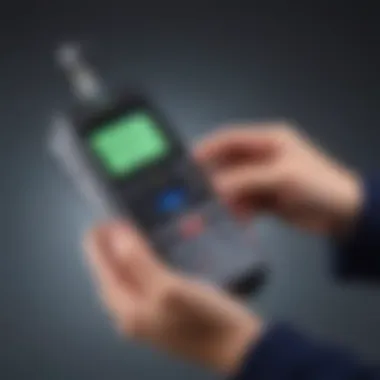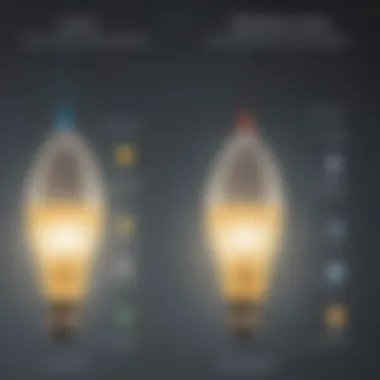Understanding Light Meters and Lumens in Science


Intro
Light is a fundamental element of our universe, essential for life and exploration. In scientific contexts, effective measurement of light is critical. This is where light meters come into play, providing precise readings that guide researchers, educators, and young learners in their scientific endeavors. This article navigates the principles of light measurement, shining a spotlight on lumens as a unit of measurement and discussing the role of light meters in various scientific explorations. By comprehending these concepts, readers can enhance their science projects and practical learning experiences.
Science Fun Facts
Understanding light and its measurement can be quite fascinating. Here are some interesting trivia and facts related to light meters and lumens:
- Did you know? The brightness of a candle at one foot away is approximately 12 lumens.
- Light travels at a speed of about 299,792 kilometers per second in a vacuum, making it one of the fastest things in the universe.
- The human eye can detect light intensities that range from about 10^(-6) to 10^3 lumens.
"Light is the fastest thing in the universe, but light meters can help us understand how bright that light is!"
These facts underscore the significance of light measurement in understanding our world.
Discover the Wonders of Science
Learning about light meters and lumens opens up a new realm of scientific exploration. Here are several educational avenues you can take:
- Exploring Various Scientific Concepts: Understand how light affects plants and their growth. Studies show that different light spectra can influence photosynthesis.
- Educational Videos and Animations: Platforms like Britannica offer engaging content that illustrates light measurements and their applications.
- Interactive Learning Tools: Using online simulators can provide hands-on experience in measuring lumens.
- Real-Life Applications of Science: Light meters are used in various fields from photography to agriculture, highlighting their importance in day-to-day life.
Science Quiz Time
Engaging with light and its properties can be enhanced through quizzes. Here are some ideas for interactive learning:
- Multiple Choice Questions: What is a lumen? A) A measure of light; B) A measure of sound; C) A measure of temperature.
- Brain Teasers and Puzzles: Create a riddle about the properties of light for your friends to solve.
Using gamification encourages further exploration and understanding of complex scientific concepts.
Science Experiment Showcase
Experimenting with light can be both fun and educational. Here is a simple experiment using a light meter:
Fun and Engaging Experiment: Measuring Light
Materials List:
- A light meter (you can find inexpensive options online)
- Various light sources (like a lamp, candle, and the sun)
- Notebook for recording your findings
Step-by-Step Instructions:
- Calibrate your light meter according to the instructions.
- Measure the light intensity from a lamp at a distance of one foot. Record the lumens.
- Repeat the process with a candle and outside in sunlight.
- Compare the results and analyze how different sources produce varying light intensities.
Safety Tips and Precautions:
- Avoid looking directly at bright light sources to protect your eyes.
- Keep flammable materials away from open flames.
Through these practical experiments, young learners will gain hands-on experience and deeper insight into the importance of light measurement.
Prelude to Light and Its Importance in Science
Light is crucial to many aspects of scientific exploration. It serves not only as an essential component of various phenomena but also provides valuable data across numerous fields, from biology to physics. Scientists aim to deepen their understanding of light, which in turn enhances our comprehension of the universe. This article will discuss the significance of light, especially in relation to light meters and lumens, guiding readers through basic definitions and applications.
Defining Light in Scientific Terms


In scientific terms, light can be defined as electromagnetic radiation that can be sensed by the human eye. It encompasses a spectrum of wavelengths, with each wavelength corresponding to a distinct color. The visible spectrum ranges approximately from 380 nanometers (violet) to 750 nanometers (red). Beyond this range, there are ultraviolet rays and infrared rays, which are not visible to the naked eye but still play significant roles in various scientific applications.
From a physics perspective, light exhibits dual characteristics. It behaves both as a wave and as a particle, often referred to as wave-particle duality. This means light can travel in waves while also being composed of photons, the particles that carry electromagnetic energy. Understanding these properties is fundamental to comprehending how light interacts with matter and how it can be measured.
The Role of Light in the Natural World
Light plays a vital role in nature, impacting life on Earth in various ways. It is essential for photosynthesis, the process by which plants convert light energy into chemical energy. This conversion results in oxygen production, which is crucial for the survival of many organisms, including humans.
Moreover, light influences climate and weather patterns. It heats the Earth's surface and drives atmospheric systems, affecting everything from ocean currents to wind patterns. As we explore light's influence, it becomes evident that the study of light is more than just a scientific inquiry; it is intrinsically linked to environmental health and sustainability.
"Understanding light and its properties can unlock a variety of applications, ranging from agriculture to renewable energy."
In addition to biological processes, light is fundamental in technologies like cameras, fiber optics, and various forms of scientific measurement. Light meters, for instance, rely on accurate measurements of light to enhance the understanding of environments, making them an essential tool in scientific research and experimentation.
By recognizing the profound importance of light in scientific contexts, learners can better appreciate how light meters and lumens serve as practical tools in their explorative endeavors.
What is a Light Meter?
Understanding light meters is crucial in the field of scientific exploration. They are essential tools for accurately measuring light intensity in various environments. Light meters help scientists and educators quantify lighting conditions, which can significantly affect experimental results. By comprehending the functional aspects of light meters, readers can better appreciate their role in enhancing scientific investigations and learning experiences.
Historical Development of Light Meters
The history of light meters dates back to the need for accurate light measurement. Early devices were rudimentary and often relied on visual estimation or simple mechanical principles. The first true light meter, known as the photometer, was developed in the 18th century. Photometers assessed light intensity by comparing two light sources.
As technological advancements occurred, light meters evolved. The introduction of the selenium light meter in the 1930s marked a significant breakthrough. This type used a photoelectric cell that converted light into electrical signals, providing more precise measurements. Today’s light meters utilize digital technology, resulting in improved accuracy and ease of use. Various tools are available, each with specifications that cater to different scientific and educational needs.
Types of Light Meters: An Overview
Light meters can be categorized into several types, with each serving distinct purposes. Understanding these types is beneficial for selecting the right tool for scientific activities. Here are some common types of light meters:
- Incident Light Meters: Measure the amount of light falling onto a subject. This is useful for assessing overall lighting conditions in a space.
- Reflected Light Meters: Measure light that bounces off a subject. This type is often used in photography and cinematography.
- Digital Light Meters: Offer real-time readings and can store data for later analysis. The digitized display enhances readability and interpretation.
- Laboratory Light Meters: Specialized for scientific research, providing high accuracy and often allowing users to calibrate for specific wavelengths.
Using these specialized light meters can significantly affect data accuracy in experiments and educational projects. Collectively, they enhance the understanding of light's role in both nature and science.
Light meters are invaluable tools for interesting experiments in classrooms and laboratories. They empower users to explore the world of light in a structured manner.
Understanding Lumens
Exploring luminosity is vital in science. In this section, we will clarify why understanding lumens is crucial. Lumens quantify light output from a source. Emphasizing this measurement helps both students and educators grasp the intensity and quality of light in various environments. Knowledge of lumens can enhance experimental accuracy and facilitate better learning outcomes in science projects.
Defining Lumens: A Standard Measurement
Lumens is a term used in photometry. It measures luminous flux, which describes the perceived power of light. One lumen is equivalent to the light emitted by a one-candela source over a solid angle of one steradian. This standard unit helps compare various light sources accurately. For instance, a typical light bulb might produce 800 lumens, while a bright LED flashlight can emit over 1,000 lumens. Understanding this helps in choosing the right lighting for specific tasks.
The knowledge of lumens has practical implications, particularly in educational settings. When students understand how to measure and interpret lumens, they can design experiments that require specific light conditions. This knowledge is essential for experiments involving plant growth, photography, or visual perception studies.
Difference Between Lumens and Other Light Measurements
Lumens is not the only term related to light measurement. Other common terms include lux and nits, and they each serve distinct purposes.
- Lumens: Measures the total light output from a source.
- Lux: Defines light intensity on a surface, one lux corresponds to one lumen per square meter.
- Nits: Reflects the brightness of displays and screens, defined as one candela per square meter.
Understanding these differences is vital in scientific exploration. While lumens provide a measure of total light emitted, lux focuses on light density impacting a surface area. This space-to-light relationship can influence experiment outcomes and data interpretation.
"Understanding different measurements of light enables students to choose the right tools for their scientific endeavors. This knowledge foundation will serve them in many practical applications."


How Light Meters Measure Lumens
Understanding how light meters measure lumens is crucial for grasping their role in scientific exploration. Light meters are instruments designed to quantify light intensity, providing insights into environmental conditions. These measurements are essential for experiments, especially in educational settings, where precise light conditions can affect outcomes. By measuring lumens, we can ensure that experiments are conducted under optimal lighting conditions, which in turn fosters better learning experiences.
Mechanics Behind Light Measurement
The mechanics involved in measuring light with a meter is both fascinating and integral. Light meters primarily function through photodetectors, which are sensitive devices that respond to light. Two common types of photodetectors include silicon photoresistors and photodiodes. These devices capture the light that falls upon them, converting it into usable data.
When light hits the sensor, it generates an electrical signal. This signal is then translated into a numerical value, representing the intensity of light in lumens. Accurate measurement relies on calibration. Most modern light meters come calibrated from the factory but might require manual adjustments depending on specific conditions and contexts. Understanding how the meter converts light to data helps users make informed decisions during experiments.
It's worth noting that environmental factors, such as the presence of other light sources, can influence readings. Thus, consistent methodology is key. Users should ensure their meters are exposed only to the light they intend to measure.
Interpreting the Data Collected by Light Meters
Once the light data is collected, interpreting this information effectively is the next step. Light meters typically display results in lumens or lux; understanding these units is fundamental for correct analysis.
- Lumens measure the total amount of visible light emitted by a source.
- Lux, on the other hand, accounts for lumens per square meter, giving context to the level of illumination over a specific area.
When engaging in experiments, students and educators should pay attention to these differences. For instance, a reading of 1000 lumens from a bulb indicates its total output, while a lux reading helps determine how well-lit a workspace is.
"Accurate data interpretation not only enhances scientific inquiry but also promotes a deeper understanding of lighting concepts."
To effectively use the readings:
- Compare data against recommended levels for various experiments.
- Document light conditions over time to observe changes.
- Discuss results with peers to foster collaborative learning.
By following these steps, individuals can maximize the learning potential of their experiments. Overall, understanding how light meters measure lumens equips both young learners and educators with valuable skills in the realm of scientific exploration.
Practical Applications of Light Meters in Experiments
Light meters are invaluable tools in scientific exploration. Their use spans various fields, providing essential measurements that enable researchers and students alike to better understand light's properties. When applied in experimental settings, light meters offer practical benefits that facilitate deeper learning and accurate results.
Using Light Meters in Classroom Projects
In educational settings, light meters can be implemented in numerous creative and hands-on projects. For instance, students can measure light intensity during experiments involving plants. By monitoring how different light levels influence plant growth, students gain firsthand knowledge of phototropism. This connection between theory and practice enhances understanding and retention of scientific concepts.
Using light meters, students can also explore phenomena such as color temperature or the impact of shading on light intensity. Engaging with these measurements helps demystify abstract concepts and encourages inquiry.
"Light meters provide students with a tangible way to connect their experimental results with real-world applications."
In addition, using light meters in light-based art projects can bridge science and creativity. By manipulating light and shadow, students learn principles of both art and physics, fostering a multi-disciplinary approach.
Importance of Accurate Light Measurement in Experiments
Accurate light measurement is crucial for valid experimental results. Light meters quantify how much light is available, impacting everything from plant biology to optical physics. If measurements are inaccurate, conclusions drawn from experiments may lead to misinterpretations.
For example, in chemistry, the effectiveness of light in photochemical reactions depends on specific wavelengths and intensities. Without precise measurements, outcomes can vary widely, undermining the reliability of the results.
Moreover, understanding the significance of lumens, the measurement of luminous flux, helps students grasp how light influences energy consumption and efficiency in various applications. This knowledge is fundamental as the world shifts towards sustainable practices.
In summary, practical applications of light meters in experiments not only enhance educational experiences but also prepare young learners to engage critically with scientific inquiry. By understanding and utilizing these instruments, students can witness the direct impact of light on their projects and experiments.
Educational Resources and Activities Involving Light Meters


Educational resources regarding light meters and their practical applications are crucial for effectively teaching this subject to young learners. Understanding how to integrate light meters in various activities fosters a hands-on experience that can enhance comprehension. Learning can be fun and interactive, leading children to grasp the principles of light measurement more effectively. Utilizing such resources not only engages students but also helps them appreciate the scientific method through experimentation.
Exploring Simple Experiments with Light Meters
Simple experiments are an excellent way to introduce students to the concept of light measurement. One basic experiment is the comparison of light intensity in different settings. For instance, students can use a light meter to measure light from an incandescent bulb and compare it with light from a fluorescent bulb. This activity promotes curiosity and critical thinking. It helps students observe how different light sources can vary in brightness, even over short distances.
Another experiment could involve measuring the effect of distance on light intensity. Students can set up a light source and progressively move a light meter away, noting the changes in readings. This demonstration illustrates the inverse square law and its practical implications in real-world scenarios. These experiments not only teach students about light but also encourage them to ask questions and think scientifically.
Interactive Learning with Light Measurement Tools
Interactive learning tools serve as an engaging complement to traditional teaching methods. Using apps or digital interfaces connected to light meters can enhance the learning experience. These tools often include interactive features that visualize data in real time, making the learning process more dynamic. Students can analyze their findings and share insights with classmates, promoting collaboration and discussion.
In addition, workshops and science fairs can incorporate light measurements into various projects. For example, a student could design a project to evaluate which materials best block light using a light meter. This could involve creating a small experimental setup with different materials and measuring how much light passes through each one. Such activities heighten interest in scientific exploration.
"Practical experimentation is not just about measuring; it's about understanding the world around us."
Engaging young learners with light meters can greatly enrich their scientific education, preparing them for future exploration.
Safety Considerations When Using Light Meters
When employing light meters in both educational settings and scientific exploration, safety considerations are paramount. These devices, while instrumental in measuring light intensity and helping students and researchers understand luminosity better, require thoughtful handling to ensure a safe and productive experience. Understanding safety guidelines helps minimize potential hazards during experiments, supporting a smoother learning process and fostering a culture of safety.
Proper Handling and Usage Guidelines
Proper handling techniques are essential when working with light meters. Here are some essential guidelines:
- Read the Manual: Always read and thoroughly understand the user manual that comes with the light meter. It contains critical details about the device’s operation, limitations, and specifications.
- Keep the Meter Clean: Dust and dirt can affect readings. Regularly clean the light sensor with a soft, dry cloth to maintain its accuracy.
- Avoid Sudden Movements: When measuring light, try to keep the device steady. Sudden movements can lead to inaccurate measurements or damage to the light meter.
- Store Correctly: When not in use, store the light meter in a protective case, away from direct sunlight and moisture, to prolong its lifespan.
These guidelines help users enjoy a seamless experience and protect the integrity of the light meter.
Awareness of Light Exposure Risks
It's also important to be aware of light exposure risks associated with using light meters. While light meters are designed to measure light levels, excessive exposure to bright light sources can lead to:
- Sensor Damage: Overexposure to strong light can damage the sensor, leading to inaccurate readings or complete failure of the device.
- Eye Protection: Bright light sources, especially ultraviolet (UV) light, can harm eyes if viewed directly. Always use appropriate shielding or protective eyewear when measuring light levels in high-intensity situations.
Understanding these risks fosters a safe environment, ensuring that children and educators engage in scientific exploration responsibly.
"Safety in the laboratory is everyone’s responsibility. By following proper protocols, we create a safer and more enriching learning experience."
Future of Light Meters in Scientific Exploration
The future of light meters holds substantial promise for improving how scientists, educators, and researchers measure light during various experiments and studies. As technology advances, the capabilities of light meters will evolve, making them more accurate, user-friendly, and efficient. This enhancement in technology will ensure that a new generation of learners can harness the power of precise light measurement, thereby enriching their understanding of scientific principles. Furthermore, light meters will likely play an increasingly vital role in fields that rely on accurate light measurement, such as photography, agriculture, and environmental science.
Innovative Technologies in Light Measurement
Innovations in light meter technology have the potential to revolutionize how we perceive and manipulate light in scientific exploration. Some of the key advancements include:
- Smart Light Meters: These devices integrate digital features and artificial intelligence. They can analyze light conditions and offer real-time feedback, making them easier for young learners to use.
- Wireless Connectivity: Newer light meters may have Bluetooth or Wi-Fi capabilities, allowing users to sync data with smartphones or tablets for deeper data analysis.
- Multi-functional Sensors: Future meters might combine various measurements, such as color temperature and illumination levels, into a single device. This will simplify the complex process of gathering light data.
- Enhanced Calibration Techniques: More precise calibration technology can provide accurate readings over diverse environments.
These technologies will make light meters more accessible to learners and enhance the exploration of light-related phenomena.
The Role of Light Meters in Advancing Scientific Research
In the realm of research, light meters are set to play an integral role. As we push the boundaries of scientific inquiry, accurate and consistent light measurements will be invaluable. Consider the following aspects:
- Facilitating Accurate Data Collection: A good light meter ensures that the data collected during experiments involving photosynthesis or other light-sensitive processes are trustworthy and reproducible.
- Supporting Diverse Research Fields: From studying climate change to examining plant growth, light meters will provide essential data that inform our understanding of these topics.
- Encouraging Transparency in Research: With more advanced light measurement tools, scientists can share their methods and data more transparently, enhancing the credibility of their studies.
"Accurate light measurements are fundamental to many branches of science, impacting our understanding of natural phenomena."
In summary, the future of light meters in scientific exploration involves exciting advancements that will empower both educators and researchers. By leveraging innovative technologies and ensuring precise data collection, light meters will continue to enhance our comprehension of light's role in science.







